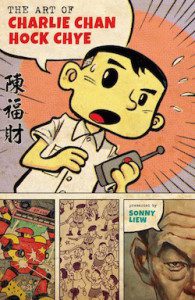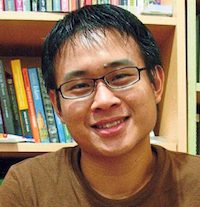
In The Art of Charlie Chan Hock Chye, Sonny Liew explores the delicate balance of past and possibility through the titular Charlie, a 76-year-old, uncompromising comic artist we’ve never heard of. Presented in the form of an interview, this graphic novel is a chronology of Charlie’s repression and frustration as Singapore undergoes its 60-year journey to become a sovereign nation. Presented alongside this political history is Charlie’s ever-expanding artistic style which mirrors the history of comics. Charlie creates a dizzying portfolio of everyday sketches, political satire, educational materials, science fiction, and of course, a superhero. But his unwavering devotion to the integrity of his craft has left him alone, living in obscurity with a growing collection of pieces he will never show anyone.
As a character Charlie isn’t very memorable—perhaps the story’s greatest misstep—and few if any pieces of dialogue remain with you. But through Charlie’s personal works, readers are treated to something wholly original in graphic storytelling. We get to see these unpublished stories. We become Charlie’s secret readership.
As the “presenter” of this story, Sonny Liew draws in various styles and mixed-media to create a sense of wonder. The book enchanted me in such a way that I questioned if Charlie is based on a real historic figure. We see protest posters, newspaper prints, magazine mockups, and unfinished sketches of neighbors in repose. At one point we’re presented with a photograph of a doll in the likeness of a character from Charlie’s first comic. According to the caption, this doll was handmade for Charlie’s 50th birthday by his first and only love, the spitting image of actual Chinese actress Lucilla Yu Ming. We aren’t just reading a comic about comics, we’re engaging with an artifact from another culture.
As a Malaysian-born artist who now lives in this country, Liew intends to resolve our unfamiliarity with the island-nation by including all the pertinent people and changes of the last century. He wants to educate as many readers as possible, moving them to see Singapore as he does— though I believe only the most invested of us will seek the primary source material in the “Notes” section he studiously provides. As history unfolds we’re given a cast of politicians and historical figures that move Singapore away from British colonialism, embrace communism, reject it, merge with the Malaya peninsula, separate, and finally settle on isolation.
Perhaps the most mature of Charlie’s comics is an alternative history à la Philip K. Dick’s The Man in the High Castle. Charlie envisions Singapore as a quasi-utopia, relishing its hard-fought independence and economic growth, while Charlie is the nation’s greatest treasure as a comic creator of prolific and staggering success. But this is not how things are, and the fabric of reality tears away to revert people and choices back into their proper places. This comic-within-a-comic has more heart than any of Charlie’s others, and culminates in the realization that regardless of the outcome, acts of courage and compassion are the true markers of a worthwhile life.

It is easy to forget that Liew is the actual artist of this amazing portfolio/collage. He demonstrates an almost inhuman amount and diversity of skill. Like any great creator, he has stepped aside so his creation can live a life of its own. Charlie is aged, single, quiet, ruffling no feathers, working menial jobs to eke out a faint existence. He believes all other comics are “rubbish”—the same criticism he once received. He shows us some drawings he’s been dwelling on for years, like a grandparent pulling out a yellowed photograph of an old friend. We smile, and nod appreciatively. There’s a sadness implicit in Charlie’s private and unfinished comics. We want more for him, and we expected more from him. He is, after all, the most strident critic of how Singapore’s policies are affecting its people, but he’s ultimately talking to himself. In a truly interesting turn, Sonny Liew addresses this notion of what could’ve been versus what can be by highlighting his own caustic views regarding the nation he calls home.
Finally, Liew’s comic avatar finds his purpose when he appears on nearly every page in a strip layout beneath one of Charlie’s satirical comics. In this strip Liew contextualizes the artists’ story with additional information and vehement opinions, even adding a younger Singaporean for Liew to “teach.” His avatar is more outspoken and passionate in three panels than Charlie is throughout the entire novel—as a side note, Singapore’s National Arts Council withdrew a grant from Liew on that grounds that The Art of Charlie possessed content that opposed the authority of the government.
At first I felt this fervor was jarring—not for its frustration or anger, but for its segregation in a single chapter in the latter half of the book. Upon reflection I realized Liew was building himself up as a counterpoint to his own creation, waiting for Charlie’s past to be told so that he could discuss the future, representing what is possible as opposed to what was. In a completely satisfying turn, Liew has become the prominent voice, publishing a comic for all to read that openly criticizes the political choices Singapore has made and is making. This is an act Charlie would never undertake, and one that makes us question our own role in the world around us.
Ultimately, Sonny Liew has compiled a work of fiction so innovative and thoughtful that even the most observant reader can’t distinguish fact from fiction, biography from creation, memory from truth. And why should we? It’s a quiet story about an individual’s purpose, where one fits into society, how to live, the passion of good work, what else we should’ve done, and, perhaps the most important notion of all, what is possible. It invites, not demands, that we focus on the now, and let the past be past.




